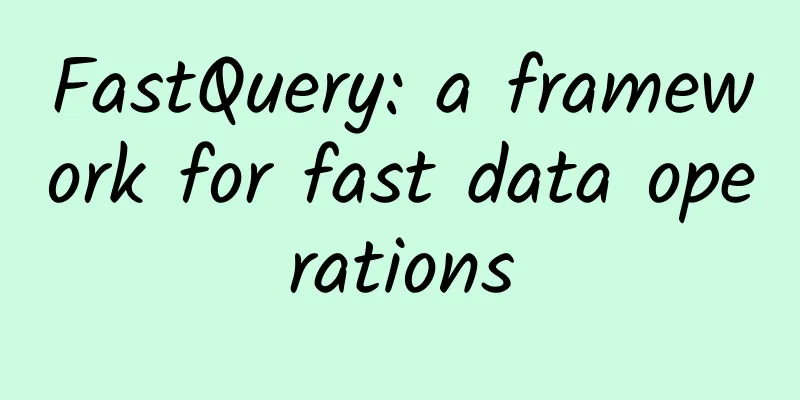FastQuery: a framework for fast data operations

|
FastQuery fast operation data layer framework FastQuery is based on Java language. Its mission is to simplify the Java operation data layer. As a developer, you only need to design and write the DAO interface, which is dynamically generated and implemented by ASM internally, and executes quickly. Therefore, the code is concise and elegant, thus greatly improving development efficiency. The main features of FastQuery are as follows:
Operating environment requirements JDK 1.8+ Configuration Files jdbc-config.xml Used to configure support for jdbc. Note: If a connection pool is used, this configuration file can be omitted.
c3p0-config.xml Support c3p0 configuration, please refer to the c3p0 official website for detailed configuration: http://www.mchange.com/projects/c3p0/ .
fastquery.json Configure the scope of the data source
A complete introductory example
|
<<: Implementing image recognition in Web development based on Google Vision API and Ionic
>>: Creating JavaScript modules with Babel and ES7
Recommend
Featured | How do major brands write Father’s Day copy?
Father's Day, as the name suggests, is a holi...
Baidu covets the mobile phone market: Is iQiyi just a pathfinder?
Yesterday, iQIYI held a press conference in Beiji...
Marketing planning and promotion: How to create Labor Day H5?
The May Day holiday is a hot topic, so brands cer...
Bidding promotion plan for the wedding photography industry!
1. Overview of the wedding photography industry b...
Case analysis: How are promotional marketing activities planned and implemented?
Next, let’s talk about the design forms of market...
Mobile phones are getting more powerful, but they still have flaws, and these three are the most serious
Although mobile phones have been developed for so...
XCMG and Oracle NetSuite establish a relationship to consolidate digitalization and welcome the new era of internationalization 2.0 development
As the world's third largest construction mac...
World Cycling Day丨The secret of balance in small wheels: you only need strength and you to make the bicycle run smoothly
Produced by: Science Popularization China Author:...
Is it a "leader" or a "useless"? Bull remote timing remote control socket review
The cost of sockets in smart homes is the lowest,...
Female stars' hip twisting and twisting set off a trend of imitating, doctors warn: there is a risk of injury →
Recently, an artist's "hip twisting"...
9 major processes of Tik Tok live streaming, a must-have operating guide for beginners!
In our previous articles, we have shared many met...
4 steps, 24 methods to write copy that will make people want to order!
All advertising copy is intended to influence peo...
Ctrip Train Ticket iOS Project Development Experience Optimization Practice
Author | Dong Hai, Ctrip mobile development expe...
Scientific explanation: Why are some men so confident when they are so ordinary?
My female compatriots, I dare say that you will n...
Which company providing SEO optimization services in Xining is better? How to choose?
Nowadays, due to the increasing bidding costs, ma...






![[Live] Aihui Lu from Zego Technology: How to use Zego SDK to instantly build a real-time voice and video APP](/upload/images/67ebd739c2abb.webp)


